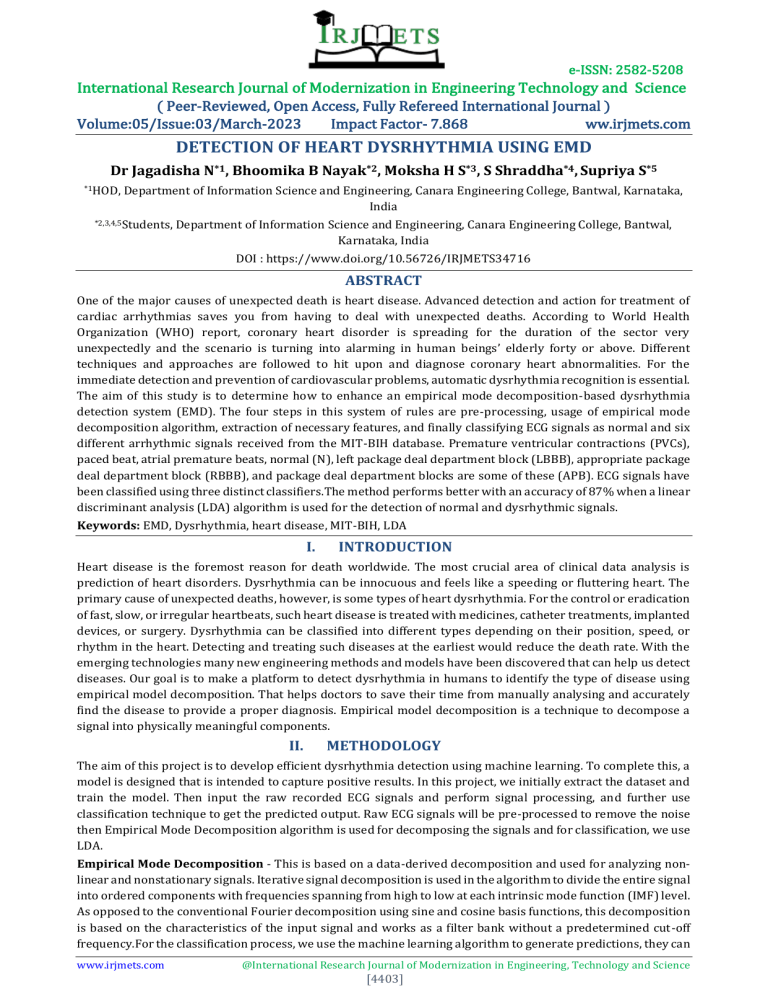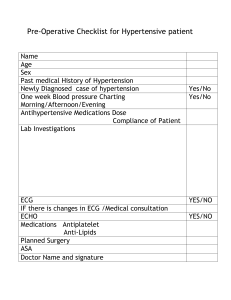
e-ISSN: 2582-5208
International Research Journal of Modernization in Engineering Technology and Science
( Peer-Reviewed, Open Access, Fully Refereed International Journal )
Volume:05/Issue:03/March-2023
Impact Factor- 7.868
ww.irjmets.com
DETECTION OF HEART DYSRHYTHMIA USING EMD
Dr Jagadisha N*1, Bhoomika B Nayak*2, Moksha H S*3, S Shraddha*4, Supriya S*5
*1HOD,
Department of Information Science and Engineering, Canara Engineering College, Bantwal, Karnataka,
India
*2,3,4,5Students,
Department of Information Science and Engineering, Canara Engineering College, Bantwal,
Karnataka, India
DOI : https://www.doi.org/10.56726/IRJMETS34716
ABSTRACT
One of the major causes of unexpected death is heart disease. Advanced detection and action for treatment of
cardiac arrhythmias saves you from having to deal with unexpected deaths. According to World Health
Organization (WHO) report, coronary heart disorder is spreading for the duration of the sector very
unexpectedly and the scenario is turning into alarming in human beings’ elderly forty or above. Different
techniques and approaches are followed to hit upon and diagnose coronary heart abnormalities. For the
immediate detection and prevention of cardiovascular problems, automatic dysrhythmia recognition is essential.
The aim of this study is to determine how to enhance an empirical mode decomposition-based dysrhythmia
detection system (EMD). The four steps in this system of rules are pre-processing, usage of empirical mode
decomposition algorithm, extraction of necessary features, and finally classifying ECG signals as normal and six
different arrhythmic signals received from the MIT-BIH database. Premature ventricular contractions (PVCs),
paced beat, atrial premature beats, normal (N), left package deal department block (LBBB), appropriate package
deal department block (RBBB), and package deal department blocks are some of these (APB). ECG signals have
been classified using three distinct classifiers.The method performs better with an accuracy of 87% when a linear
discriminant analysis (LDA) algorithm is used for the detection of normal and dysrhythmic signals.
Keywords: EMD, Dysrhythmia, heart disease, MIT-BIH, LDA
I.
INTRODUCTION
Heart disease is the foremost reason for death worldwide. The most crucial area of clinical data analysis is
prediction of heart disorders. Dysrhythmia can be innocuous and feels like a speeding or fluttering heart. The
primary cause of unexpected deaths, however, is some types of heart dysrhythmia. For the control or eradication
of fast, slow, or irregular heartbeats, such heart disease is treated with medicines, catheter treatments, implanted
devices, or surgery. Dysrhythmia can be classified into different types depending on their position, speed, or
rhythm in the heart. Detecting and treating such diseases at the earliest would reduce the death rate. With the
emerging technologies many new engineering methods and models have been discovered that can help us detect
diseases. Our goal is to make a platform to detect dysrhythmia in humans to identify the type of disease using
empirical model decomposition. That helps doctors to save their time from manually analysing and accurately
find the disease to provide a proper diagnosis. Empirical model decomposition is a technique to decompose a
signal into physically meaningful components.
II.
METHODOLOGY
The aim of this project is to develop efficient dysrhythmia detection using machine learning. To complete this, a
model is designed that is intended to capture positive results. In this project, we initially extract the dataset and
train the model. Then input the raw recorded ECG signals and perform signal processing, and further use
classification technique to get the predicted output. Raw ECG signals will be pre-processed to remove the noise
then Empirical Mode Decomposition algorithm is used for decomposing the signals and for classification, we use
LDA.
Empirical Mode Decomposition - This is based on a data-derived decomposition and used for analyzing nonlinear and nonstationary signals. Iterative signal decomposition is used in the algorithm to divide the entire signal
into ordered components with frequencies spanning from high to low at each intrinsic mode function (IMF) level.
As opposed to the conventional Fourier decomposition using sine and cosine basis functions, this decomposition
is based on the characteristics of the input signal and works as a filter bank without a predetermined cut-off
frequency.For the classification process, we use the machine learning algorithm to generate predictions, they can
www.irjmets.com
@International Research Journal of Modernization in Engineering, Technology and Science
[4403]
e-ISSN: 2582-5208
International Research Journal of Modernization in Engineering Technology and Science
( Peer-Reviewed, Open Access, Fully Refereed International Journal )
Volume:05/Issue:03/March-2023
Impact Factor- 7.868
ww.irjmets.com
be partitioned as: supervised learning and unsupervised learning. There are various methods for classifying ECG
arrhythmias. To distinguish between regular and arrhythmic signals, LDA classification approach is applied.
Figure 1: Methodology diagram
III.
IMPLEMENTATION
With the aid of MATLAB, we are carrying out our project. Several people, especially in the scientific, technical,
and mathematical disciplines, favour its implementation. Because it provides an intuitive interface that makes
writing and running code simple.Signal processing, control systems, image processing, and many other features
are available through the extensive collection of toolboxes in MATLAB. Data plotting and analysis are made
simple by its strong visualisation capabilities. High-quality 2D and 3D plots can be made using its integrated
graphics features. Other programming languages and applications like Python, C/C++, and Excel can be
seamlessly connected with MATLAB. It is simple to combine the advantages of several technologies to address
problems thanks to this integration. There are numerous steps involved in arrhythmia identification utilising
ECG readings. Preprocessing, feature extraction, and classification. This is a method that combines Butterworth
filtration and empirical mode decomposition (EMD) for preprocessing.
Linear Discriminant Analysis and Quadratic Discriminant Analysis for classification
1. Load and preprocess the ECG signal data: Get the ECG signal data from a dataset. After choosing the ECG
signal will be pre-processed, the user can choose the ECG raw signal.
2. Preprocessing: It is a vital stage in the arrhythmia ECG identification process since ECG signals are frequently
tainted with noise and artefacts, which can affect the precision of the arrhythmia diagnosis process. Preprocess
the data by employing filters like the Butterworth filter to remove any noise and artefacts.
---->fs = 1000; % Sampling frequency load
('ecg_data.mat'); % Load ECG signal
data ecg_signal = ecg_data.ecg_signal; % Extract ECG signal
ecg_signal_filtered = butterworth filter(ecg_signal, fs, 5, 50); % Apply Butterworth filter
3. EMD Method: The user can move on to the following step, which is the EMD approach, after the noise has been
removed. The filtered ECG signal should be broken down into Intrinsic Mode Functions using EMD (IMFs).This
process aids in separating the signal's fundamental elements like the P wave, the T wave, and the QRS complex.
Choose IMFs that match the P wave and QRS complex. Because it can aid in the separation of the various elements
of the ECG signal and the extraction of the pertinent features that are suggestive of arrhythmia, EMD is a crucial
approach in the identification of arrhythmia in ECGs. By identifying and distinguishing various scales of variation
in the signal, the EMD method can help break down the ECG signal into its component pieces. The IMFs, which
represent the many scales of variation in the signal, are extracted from the signal by iteratively sifting it to detect
and locate them.
www.irjmets.com
@International Research Journal of Modernization in Engineering, Technology and Science
[4404]
e-ISSN: 2582-5208
International Research Journal of Modernization in Engineering Technology and Science
( Peer-Reviewed, Open Access, Fully Refereed International Journal )
Volume:05/Issue:03/March-2023
Impact Factor- 7.868
ww.irjmets.com
4. Feature Extraction: The feature is extracted using the peak detection techniques and the Hilbert transform.
The goal of detecting R-peaks is to locate the ECG signal points that correspond to the ventricles' depolarization,
which may then be utilized to monitor and diagnose arrhythmia. By obtaining the ECG signal's maximum and
minimum, you can accentuate the R-peaks. Calculations are made to determine the R-peak amplitudes' power
spectral density (PSD). The PSD is calculated with the intention of analyzing the frequency content of the R-peaks
and locating any notable frequency components that might be arrhythmia-indicative.
5. Categorization: Finally, we will use QDA and LDA to categories the different types of arrhythmia.
In order to determine which method yields the best results, we evaluate the accuracy between QDA and LDA.
The collected features can be used to accurately classify various types of arrhythmias using the potent
classification algorithms LDA and QDA. These classification methods can be combined with EMD and Butterworth
filtering to dramatically increase the accuracy of arrhythmia identification.
Signal Processing:
With an emphasis on the analysis, modification, and synthesis of signals, including sound, pictures, potential
fields, seismic signals, altimetry processing, and scientific data, signal processing is a subfield of electrical
engineering and a geophysical area. Signal processing methods are used to improve transmissions, improve
digital storage efficiency, fix distorted signals, raise the perceived quality of video, and detect or locate particular
components of interest in a measured signal. You may analyze signals and spot patterns and trends using
MATLAB and Simulink's built-in capabilities for viewing and preprocessing signals in the time, frequency, and
time-frequency domains.
DSP System Toolbox:
A MATLAB framework for processing streaming signals is provided by DSP System Toolbox. A library of signal
processing techniques, including single-rate and multi-rate filters, adaptive filtering, and FFTs, are included in
the system toolbox and are designed specifically for processing streaming signals. You may construct and analyze
FIR, IIR, multirate, multistage, and adaptive filters with DSP System Toolbox.
For system development and verification, signals from variables, data files, and network devices can be streamed.
You may dynamically visualize and assess streaming signals using the Time Scope, Spectrum Analyzer, and Logic
Analyzer.
Empirical mode decomposition (EMD)
The EMD method iteratively divides a signal x(t) into IMFs and a residual. The algorithm's core concept is to sift
a function x(t) into a new function Y(t):
• First, determine x's local minima and maximum (t).
• Next, create the lower and higher envelopes of x using the local extrema, denoted by s(t) and s+(t), respectively
(t). Calculate the average of the envelopes, m (t)
• To get the residual, subtract the mean from x(t) as follows: Y(t) = x(t) m (t).
• Check if the identified minima and maxima are significant by comparing them with the IMF values' mean and
standard deviation.
• A significant local maximum or minimum should have a value that is significantly larger or smaller than the
mean of the IMF, respectively.
• Repeat steps 2 and 3 for each IMF to find every local minimum and maximum in the signal..
Hilbert transform:
A method for extracting the minimum-phase response from a spectrum analysis is the Hilbert transform. Any
signal energy occurring after time t = 0 will result in a linear delay component in the FFT's phase when executing
a traditional FFT. If a pulse has finite width, it will nevertheless produce this linear slope in the following FFT
www.irjmets.com
@International Research Journal of Modernization in Engineering, Technology and Science
[4405]
e-ISSN: 2582-5208
International Research Journal of Modernization in Engineering Technology and Science
( Peer-Reviewed, Open Access, Fully Refereed International Journal )
Volume:05/Issue:03/March-2023
Impact Factor- 7.868
ww.irjmets.com
phase even if it happens at time t = 0. This time delay component is inversely proportional to the slope of the FFT
phase (against frequency). Delays that are significant can result in phase deviations of more than 2. This huge
linear phase component can obscure any phase nonlinearities present in the FFT data that are of importance
(such as a minor bump). This linear-phase component will be eliminated by the Hilbert transform, which is based
on particular FFT processing. The desired "minimum phase" data is this. Both time and frequency domain signal
processing are used in the approach.
Butterworth filters:
The magnitude response of Butterworth filters is monotonic overall and maximally flat in the passband. The
lessened roll off steepness is a trade-off for this smoothness. For a given filter order, elliptic and Chebyshev filters
typically offer steeper roll off.
Using a five-step algorithm, Butter:
1. It uses the function but tap to determine the poles, zeros, and gain of the low pass analogue prototype.
2. The gain, poles, and zeros are converted to state-space form..
3. Sometimes, a state-space transformation is used to convert the low pass filter into a bandpass, high pass, or
band stop filter with the appropriate frequency bounds.
4. When designing digital filters, bilinear transformation with frequency pre warping is utilised to convert
analogue filters into digital filters. The analogue and digital filters can have the same magnitude frequency
response at Wn or at w1 and w2 with appropriate frequency tuning.
5. Depending on the situation, it converts the state-space filter back to either its transfer function or zero-polegain form.
IV.
RESULTS AND DISCUSSION
The proposed system for dysrhythmia detection using signal processing is designed to identify and classify heart
disease by processing ECG signals. The system is composed of two main components: the feature extraction from
processed signal and the classification of disease by applying a classification algorithm. We use Hilbert transform
and the peak detection algorithm for feature extraction. We are using QDA and LDA to classify the arrhythmia
type.Signal processing involves changing data such that we can recognise elements within it that aren't readily
apparent through direct inspection. With this signal processing capacity, we can analyse and dissect the ECG
signal in order to extract information. The ECG signal can be divided into intrinsic mode function using empirical
mode decomposition., which can then be filtered using Butterworth filtering to remove noise and artefacts. The
effectiveness of this approach may depend on the quality of the ECG signals were examined and the final
parameters selected. In order to achieve a correct diagnosis and the right course of therapy, it is advised that this
approach be used in conjunction with other diagnostic tools and clinical judgement..
V.
CONCLUSION
Heart disease have become the primary reason for increasing death rate across the world. In order to prevent
more damage to human lives early diagnosis for prevention and treatment for cardiac diseases is necessary. ECG
is done to determine heart rhythm(dysrhythmias) and if there are any blocked or narrow arteries in your heart.
By processing the signal of ECG, we can detect the abnormality and classify the type of arrhythmia. Our system
mainly focuses to people with early diagnosis of heart diseases and save their lives on time. We can detect the
abnormality and classify the types arrhythmia. Our system mainly focuses to help people with early diagnosis of
heart diseases and save their lives on time.
VI.
[1]
[2]
[3]
REFERENCES
Montenegro, Larissa, Mariana Abreu, Ana Fred, and Jose M. Machado. "Human-Assisted vs. Deep
Learning Feature Extraction: An Evaluation of ECG Features Extraction Methods for Arrhythmia
Classification Using Machine Learning." Applied Sciences 12, no. 15 (2022): 7404.
Ullah, Wusat, Imran Siddique, Rana Muhammad Zulqarnain, Mohammad Mahtab Alam, Irfan Ahmad, and
Usman Ahmad Raza. "Classification of arrhythmia in heartbeat detection using deep learning."
Computational Intelligence and Neuroscience 2021 (2021).
Dalal, S., Vishwakarma, V.P. “Classification of ECG signals using multi-cumulants based evolutionary
hybrid classification”. Sci Rep 11, 15092 (2021). Doi: 10.1038/s41598-021-94363-6.
www.irjmets.com
@International Research Journal of Modernization in Engineering, Technology and Science
[4406]
e-ISSN: 2582-5208
International Research Journal of Modernization in Engineering Technology and Science
( Peer-Reviewed, Open Access, Fully Refereed International Journal )
Volume:05/Issue:03/March-2023
Impact Factor- 7.868
ww.irjmets.com
[4]
[5]
[6]
[7]
[8]
[9]
[10]
[11]
[12]
Banerjee, Sayak, Arin Paul, Anshika Agarwal, and Sumit Kumar Jindal. "Real time arrhythmia detecting
wearable using a novel deep learning model." In 2020 International Conference on Interdisciplinary
CyberPhysical Systems (ICPS), pp. 14-19. DOI: 10.1109/ICPS51508.2020.00009.
M. Hammad, A. M. Iliyasu, A. Subasi, E. S. L. Ho and A. A. A. El-Latif, "A Multitier Deep Learning Model for
Arrhythmia Detection," in IEEE Transactions on Instrumentation and Measurement, vol. 70, pp. 1-9,
2021, Art no. 2502809, doi: 10.1109/TIM.2020.3033072.
Chowdhury, M., K. Poudel, and Y. Hu. "Compression, Denoising and Classification of ECG Signals using
the Discrete Wavelet Transform and Deep Convolutional Neural Networks." In 2020 IEEE Signal
Processing
in
Medicine
and
Biology
Symposium
(SPMB),
pp.
1-4.
DOI:
10.1109/SPMB50085.2020.9353618.
Ullah, Amin, Syed Muhammad Anwar, Muhammad Bilal, and Raja Majid Mehmood. "Classification of
arrhythmia by using deep learning with 2-D ECG spectral image representation." Remote Sensing 12, no.
10 (2020): 1685.
M. M. Rahman Khan, M. A. Bakr Siddique, S. Sakib, A. Aziz, A. K. Tanzeem and Z. Hossain,
"Electrocardiogram Heartbeat Classification Using Convolutional Neural Networks for the Detection of
Cardiac Arrhythmia," In 2020 Fourth International Conference on I-SMAC (IoT in Social, Mobile,
Analytics and Cloud) (I-SMAC), 2020, pp. 915-920, doi: 10.1109/I-SMAC49090.2020.9243474.
H. Yang and Z. Wei, "Arrhythmia Recognition and Classification Using Combined Parametric and Visual
Pattern Features of ECG Morphology," in IEEE Access, vol. 8, pp. 47103-47117, 2020, doi:
10.1109/ACCESS.2020.2979256.
G. Latif, F. Y. Al Anezi, M. Zikria and J. Alghazo, "EEG-ECG Signals Classification for Arrhythmia Detection
using Decision Trees," 2020 Fourth International Conference on Inventive Systems and Control (ICISC),
2020, pp. 192-196, doi: 10.1109/ICISC47916.2020.9171084.
Yin, Li, Fumin Chen, Qi Zhang, and Xu Ma. "Arrhythmia classification based on multi-domain feature
extraction." In Journal of Physics: Conference Series, vol. 1237, no. 2, p. 022062. IOP Publishing, 2019.
Patil, Anita, and Ravina D. Edake. "Cardiac Arrhythmia Detection through ECG Signals." In 2018 4th
International Conference for Convergence in Technology (I2CT), pp. 1-5. DOI:
10.1109/I2CT42659.2018.9057836.
www.irjmets.com
@International Research Journal of Modernization in Engineering, Technology and Science
[4407]





